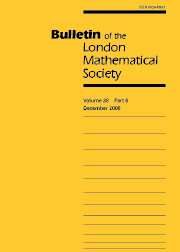Article contents
S-UNIT EQUATIONS IN FUNCTION FIELDS VIA THE abc-THEOREM
Published online by Cambridge University Press: 01 March 2000
Abstract
We consider the equation
a1x1 + ··· + anxn = 1, (1.1)
where the coefficients a1, …, an are non-zero elements of a field K, to be solved for (x1, …, xn) in a finitely generated multiplicative subgroup G of (K*)n. Evertse [2] and van der Poorten and Schlickewei [6] showed, independently, for the most important case in which K is a number field and G is a group of S-units in K, that (1.1) has only finitely many solutions (x1, …, xn) for which no subsum in (1.1) vanishes. Such solutions are called non-degenerate.
In 1990, Schlickewei [7] was the first to obtain an explicit upper bound for the number of non-degenerate solutions of (1.1) when G is a group of S-units of K. His result went through various successive improvements, and the best result to date is the bound (235n2)n3s by Evertse [3, Theorem 3], where s is the cardinality of S. Very recently, Evertse, Schlickewei and Schmidt [4, 5] obtained a remarkable result. They showed, again for K a number field, that the number of non-degenerate solutions of (1.1) with (x1, …, xn) in a finitely generated subgroup of (K*)n of rank r is at most c(n)r+2, with c(n) = exp((6n)4n). The importance of this result lies with its uniformity with respect to the rank r of the group and its independence of the field K. The proofs of the above-mentioned results are all quite difficult and depend on deep tools from Schmidt's Subspace Theorem and diophantine approximation. In this paper we consider equation (1.1) in the rational function field K = k(t) where k is an algebraically closed field of characteristic 0. Of course, results of this type will follow rather easily from the above-mentioned results by a specialization argument. However, our object is to show that our approach to the function field case is quite elementary and certainly very different, being a simple and direct consequence of the powerful abc-theorem.
Before stating our result, we first define proportional solutions of (1.1). We say that (x1, …, xn) and (x′1, …, x′n) are proportional if xi, /, x′i ∈ k, 1 [les ] i [les ] n. This determines equivalence classes of solutions.
- Type
- NOTES AND PAPERS
- Information
- Copyright
- © The London Mathematical Society 2000
- 1
- Cited by


